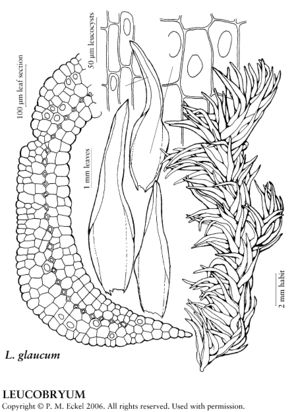Difference between revisions of "Leucobryum glaucum"
in E. M. Fries, Summa Veg. Scand. 1: 94. 1845,.
FNA>Volume Importer |
FNA>Volume Importer |
Revision as of 19:40, 24 September 2019
Plants in tall, compact cushions or turfs. Stems 1–12.5 cm (rarely shorter). Leaves 3–9 mm, limb concave to subtululose, erect or erect-spreading, sometimes falcate-secund, apex acute or apiculate, usually ± serrulate at the tip, spreading from oblong-obovate sheath, 1–2(–3) times the length of sheath; costa in transverse section near base showing lateral, thicker regions composed mostly of 2–3(–4) layers of enlarged leucocysts on both sides of the central layer of chlorocysts and a central, thinner region composed of 1 layer of smaller leucocysts adaxial to and 2 layers abaxial to the chlorocysts (or vice versa), occasionally with only 1 layer of leucocysts on both sides of the chlorocysts; lamina narrow, 5–11 cells wide. Specialized asexual reproduction by clusters of small caducous leaf-like gemmae at stem tip and by leaves with rhizoids at apex. Seta 8–18 mm, reddish. Capsule strongly inclined and curved when dry and empty, usually strumose, 1.5–2 mm, red to reddish brown; operculum 1.5–2 mm; peristome teeth dark red. Spores nearly smooth to minutely papillose, 13–18 µm.
Phenology: Capsules mature Aug–Dec.
Habitat: Humus, soil, rotting logs and stumps, tree bases, and rock ledges, forests, bogs, and swamps
Elevation: low to high elevations (0-1800 m)
Distribution
Alta., Man., N.B., Nfld. and Labr. (Nfld.), N.S., Ont., P.E.I., Que., Ala., Ark., Conn., Del., D.C., Fla., Ga., Ill., Ind., Iowa, Kans., Ky., La., Maine, Md., Mass., Mich., Minn., Miss., Mo., N.H., N.J., N.Y., N.C., Ohio, Okla., Pa., R.I., S.C., Tenn., Tex., Vt., Va., W.Va., Wis., Eurasia, Atlantic Islands (Canary Islands, Madeira).
Discussion
The collection from Alberta (Drummond’s Musci Americani 89, TENN) is probably incorrectly labeled as to locality.
Large, tall cushions distinguish Leucobryum glaucum and under favorable circumstances some cushions may exceed 1 m in diameter. The separation of smaller, shorter plants from L. albidum is difficult. The use of the number of layers of leucocysts on both sides of the chlorocysts is highly variable and not a reliable distinguishing feature. The ratio of length of the sheath to the length of the limb provides the most consistent way to separate L. glaucum from L. albidum. Sporophytes are infrequently observed. Of 1933 collectons examined, 308 (16 percent) had sporophytes. Most of the plants with sporophytes were from collections located north of the Ohio River. Leucobryum antillarum Bescherelle var. antillarum has been reported from the Coastal Plain of the United States based upon plants that had only 1 layer of leucocysts on both sides of the chlorocysts across a wide section of the median portion of the leaf as seen in transverse section near the base. However, this character is quite variable and not even consistent in L. antillarum (H. A. Crum and L. E. Anderson 1981, vol. 2). Also, plants from the coastal plain do not show the prorate cells on the lateral wings of the lamina that are present in the type material of L. antillarum.
Selected References
None.
